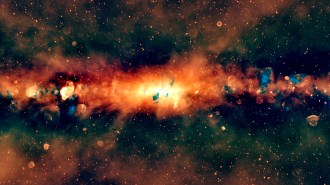PASADENA, Calif. — Dating millisecond pulsars is like trying to guess the age of a patient by listening to his heartbeat.
These compact stellar remnants spin hundreds of times a second — gaining speed over time by pulling in material from a companion star — and emit beams of radio waves that sweep past Earth like a lighthouse beacon. The period between each radio pulse and the rate at which those pulses slow have been the only clues astronomers have had to estimate the age of one of these whirling dervishes. And sometimes estimates have been ludicrously off the mark, with pulsars labeled as older than the galaxies in which they reside.
Now, astronomers Bülent Kiziltan and Stephen Thorsett of the University of California, Santa Cruz, have come up with a more accurate way to peg the ages of millisecond pulsars, they report June 8 at a meeting of the American Astronomical Society. By including in their model previously ignored features such as the maximum possible rate of rotation and subtle shifts in the observed radio frequency due to a pulsar’s motion across the sky, the team finds that some millisecond pulsars are up to 10 times younger or 10 times older than earlier estimates suggest. For instance, the millisecond pulsar PSR B1257+12, famous for harboring three planets, is now pegged at up to 8 billion — rather than 800 million — years of age, making this family the most likely candidate for oldest planetary system known.
The more accurate age determinations may lead to a better understanding of the formation and evolution of millisecond pulsars, along with new clues to the structure of the compact remnants, the researchers say.







